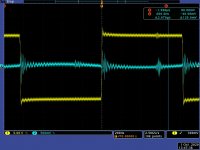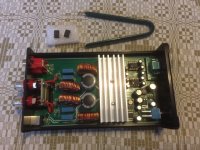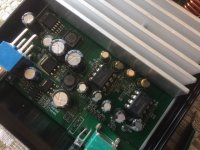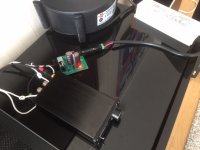I think I have some original 5532's I could try, but I'm more interested in the measurable difference with/without OA.
Will try to listen to it fed by a 30V linear supply with massive caps too.
This is very interesting.
I have the same amplifier. Can you do some measurements with the 30 V linear supply to see if the results will be even better ?
I have replaced the ne5532 with lm4562 and I think some irritating issues in the sound completely dissapeard from 4 kHz -10 KHz . More clean and more dynamic sound with lm4562.
I can see when I get the time.
It could be a bit tricky to compare the measurements taken at different times with different setups. Worst case the measuring cables etc will pick up a lot of hum etc from the linear supply.
Previous experience tells me there will probably not be any measured difference from the type of supply(except obvious issues from bad ripple etc), but my guess is that the higher supply voltage could make some minor difference. -For better or for worse, I can't say.
It could be a bit tricky to compare the measurements taken at different times with different setups. Worst case the measuring cables etc will pick up a lot of hum etc from the linear supply.
Previous experience tells me there will probably not be any measured difference from the type of supply(except obvious issues from bad ripple etc), but my guess is that the higher supply voltage could make some minor difference. -For better or for worse, I can't say.
When it comes to subjective vs measurements, I go for a combination.
I have amps that measure really great, but I hated the sound. On the other hand I have heard amps I liked, that did not measure as good (but 'ok'), but after improving the measured performance, they also sounded better. But, what suits my ears, might not suit others.
I have amps that measure really great, but I hated the sound. On the other hand I have heard amps I liked, that did not measure as good (but 'ok'), but after improving the measured performance, they also sounded better. But, what suits my ears, might not suit others.
Doctor, did you compare the A04 with your project?Pojaluysta))))))
[offtopic]С приветом из Казани!
@kokoriantz
I think that when I looked at the FFT turning volume up and down before, the harmonics disappeared into the background noise at low volume.
I think that when I looked at the FFT turning volume up and down before, the harmonics disappeared into the background noise at low volume.
The 10V output gets a bit ugly, maybe because of mild saturation of the output inductors, or possibly it could need some extra cap on the supply?
The 6+7kHz test is something I started doing recently, and it seems pretty revealing of IMD. I have only measured one 'homebrew' AB amp in this way, and it gave similar results. Does not look too nice in my eyes, but as I said, I have very little reference.
I'm listening to the amp now, in the same configuration as measured. It is probably sounds better than any other class D I have heard, but none of them have been top end class D.
I'm a bit disappointed about the bass 'drive', I was expecting more control and extension somehow. Maybe an extra cap on the supply could do something to improve it.
It also seems to get a bit 'unclear' with 'busy' music. Mostly mid and treble. Treble seems a bit bright and like there is hiss added to it. And a hint of headache is beginning after some hours of listening now.
I'm thinking I should try the extra cap on the supply, and I would like to bypass the op-amps and measure it again. I'm also a bit keen to try PFFB as in Ti 'application report', but that would probably mean messing around with the SMD resistors and caps on the board, and I'm not keen on that..
Once again - thank you for the measurements.🙂
The way you describe the sound from the unmodified Aiyima a04 is exactly the way I would describe the sound with the stock ne5532. All of those issues dissapeared when I changed IC to a lm4562.
You should try it🙂.
Maybe the less good results at 10 V is because of a bad OP amp that dont like to deliver the voltage or current needed ?
I have sent my ne5532 for investigation by a professional if it might be a lm358 fake IC or a real ne5532. I will report the results here. [/QUOTE]
Attachments
Last edited:
I personnaly tested the Aiyima A04 (I mean the Tilear R 2.1 version) which is the best version with Elna caps + these OP amps :
- Burson V5i (they are more expansive than the amplifier itself)
- OPA1622
- OPA1612
- OPA627
- OPA1656
- Muse 01
Keep on saying that OPA1656 provide me the best results (excellent sound stage, dead silence and very analytic). I am using some high ends floor speakers handcraft with ribbon tweeter 100W / 93DB / 2.5 way.
On the other hand, they do not forgive the defaults on bad audio sources.
- Burson V5i (they are more expansive than the amplifier itself)
- OPA1622
- OPA1612
- OPA627
- OPA1656
- Muse 01
Keep on saying that OPA1656 provide me the best results (excellent sound stage, dead silence and very analytic). I am using some high ends floor speakers handcraft with ribbon tweeter 100W / 93DB / 2.5 way.
On the other hand, they do not forgive the defaults on bad audio sources.
I took a quick look at the output filter, and it looks good. No oscillation problems as I see it. The small spikes on the output seen 'between flanks' are from the switching on the other channel.
Looks fine🙂
Do you have the opportunity to do some more measurements with another IC than ne5532 and with your linear power supply ?
I had only one genuine 5532 left, so I ordered another pair, and a pair of lm4562.
The local supplier did not have OPA1656. I'm also not prepared to spend a lot more on this amp.
The local supplier did not have OPA1656. I'm also not prepared to spend a lot more on this amp.
I measured distortion comparing the delivered 5532 vs genuine 5532 vs 4562, there is basically no difference. I could se a few dB's difference on some harmonics low down, and that is within measurement tolerance I would say. I used one channel as reference with the delivered OP-amp, and swapped op-amps on the other channel.
Tested with a regulated 24V bench supply, and it does seem that lowering the voltage from 24V while watching the FFT raises the distortion a bit (more difference than changing op-amps).
Tested with a regulated 24V bench supply, and it does seem that lowering the voltage from 24V while watching the FFT raises the distortion a bit (more difference than changing op-amps).
Last edited:
I also changed it's original 5532 to 4562, using my 19V notebook power. That's lots of difference in my sense of hearing. I would suspect my 5532 shipped with it are not genuine, or it's possibly affected by low power voltage ?
* my A04 is green board version
* my A04 is green board version
I can now verify that a very competent amplifier engineer has done measurements on the stock ne5532 in Aiyima a04 and the result is this:
The ne5532 is NOT a fake IC. It behaves exactly the same as a genuin ne5532.
faktiskt.io • Visa trad - Ljudmassig utvardering av tpa3251 Aiyima A04 - klass D
The ne5532 is NOT a fake IC. It behaves exactly the same as a genuin ne5532.
faktiskt.io • Visa trad - Ljudmassig utvardering av tpa3251 Aiyima A04 - klass D
Last edited:
I agree on the OP-amp, I even measured directly on the output from the op-amp, and could not see any difference in distortion between the supplied one and the genuine.
I did try listening too, and to my ears there seems to be some difference with the 4562. Not much, but something in the mid/treble sounds a little bit different. However, in bass it still sounds the same. I would prefer some more control in the bass. This time I used a 10000uF cap on the supply from the 19,5V laptop brick.
BTW, my speakers are an easy load, minimum of 6ohm around 100Hz and phase is max +-30deg in the audio band.
I did try listening too, and to my ears there seems to be some difference with the 4562. Not much, but something in the mid/treble sounds a little bit different. However, in bass it still sounds the same. I would prefer some more control in the bass. This time I used a 10000uF cap on the supply from the 19,5V laptop brick.
BTW, my speakers are an easy load, minimum of 6ohm around 100Hz and phase is max +-30deg in the audio band.
I use a capacitance multiplier from Allo. Its the same as having 1000000 uF .
Everything in the sound becomes slightly better with the capacitance multiplier, especially in the bass.
It only costs 17 dollars from Allo as stand alone. I can recomend it.
Iˋm using a mean well 24 v 6,3 A switch mode supply.
Everything in the sound becomes slightly better with the capacitance multiplier, especially in the bass.
It only costs 17 dollars from Allo as stand alone. I can recomend it.
Iˋm using a mean well 24 v 6,3 A switch mode supply.
Attachments
Last edited:
- Home
- Amplifiers
- Class D
- Aiyima A04 TPA 3251 measurements, and maybe more



